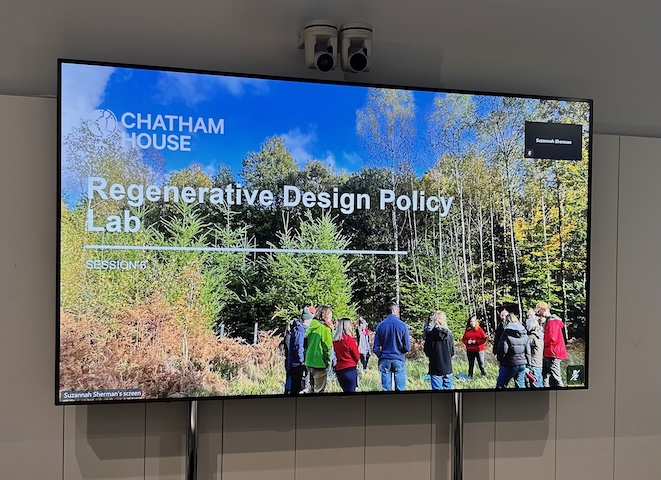On February 4th, our current cohort of the Regenerative Design Lab returned to Chatham House London. In this session hosted by our delivery partners, the Chatham House Sustainability Accelerator, our aim was to deepen understanding of system change, policy change and the Ambition Loop model.
Exploring systems change and partnerships
One of the ideas we have been exploring in this lab is how policy changes can take hold. According to the Ambition Loop model, for a change in the system to form and grow we need alignment between communities, business and government/regulation.
We designed this session to strengthen their personal enquiries into regenerative design and policy by:
- Exploring in more depth the Ambition Loop concept.
- Discussing the concept of creating a policy window and what causes a policy window to open up.
- Identifying who are partners are in creating change – both partners that are close in and further out.
Chatham House provides a fitting stage for these conversations, located so close to the heart of government, complementing the conversations we had in the woods in January.
Key takeaways
Reflecting on the session, the Policy Window Concept seemed to strike a chord, helping participants see that as well as having a good idea, the conditions need to be right for that idea to take hold. The Crew/Congregation/Crowd model was useful for thinking about how we relate to the different parts of the Ambition Loop we are trying to connect up. We will be adding both of these models to our growing set of regenerative design tools.
A highlight of the afternoon was a case study presented by Mary Stevens from Friends of the Earth about the long journey of establishing doorstep recycling in the UK. The story took us from the small-scale experiments of Avon Friends of the Earth through to legislative change. This real-world example illustrates well the need to align communities, business and regulation but also underlines how long it can take to make change.
A valuable insight came from Mary’s observation that often in this work, where it starts to feel hard is probably where we need to take the work. For participants in every cohort there has always been the question of how to carry out their enquiry. Mary’s observation is a good prompt for regenerative designers to lean into the challenge they face.
This fourth cohort of the Regenerative Design Lab has a policy emphasis and the tools we worked with in this session really served to solidify understanding of work in the policy space. We are looking forward to seeing where the participants take their work in the final months of their Lab journey.

